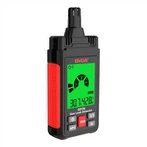A guide for operating a microscope
1. How to use:
1. Place the instrument on the object to be measured, so that the measured part of the object to be measured is illuminated by natural light or light, and then adjust the screw of the eyepiece to make the reticle and the object image clearly visible in the field of view at the same time;
2. When measuring, first rotate the reading drum to move the glass reticle engraved with filaments, and at the same time turn the reading microscope slightly so that the vertical filaments are aligned with the measured part for measurement;
3. See a magnified round hole dent in the field of view. When measuring, first rotate the reading drum to make the vertical filament in the field of view tangent to one side of the round hole dent, get a reading, and then rotate the reading Drum, so that the vertical filament is tangent to the other side of the hole dent, and another reading is obtained;
4. The diameter of the dent in the round hole is the difference between the secondary readings, and it is the thickness of the insulation
2. Matters needing attention:
1. When the instrument can be used normally, never disassemble it by yourself, otherwise it will damage the original accuracy of the instrument;
2. When storing and using the instrument, avoid dust, humidity, overheating and acid-base vapor;
3. Dirt on the surface of the lens must be wiped with soft objects such as absorbent cotton, soft brush, and lens paper.
Three examples:
1 Put the micrometer microscope on the surface of the object to be measured, with the notch of the mirror base facing the direction of the light, press and hold the mirror base (8) to adjust the eyepiece (2) to make the reticle in the visual field clear, and turn the mirror base to adjust The focus ring (7) makes the object under test magnified and imaged by the objective lens clearly on the eyepiece reticle (3), loosen and lock the lens holder (1), then lock the object to be measured, and turn the micrometer drum Wheel (5), make the reticle with a cross and double engraved lines to aim at the image of the measured object, the boundary of the measurement area needs to be measured, read the integer value on the fixed ruler plus the mantissa value on the micrometer drum, and it is the measured value. Measure the starting point of the boundary of the object image (a), and then turn the micrometer drum to make the reticle with a cross and double engraved line aim at the other end boundary of the area to be measured, and read the integer value on the fixed scale plus The mantissa value on the upper micrometer drum is the end reading (b) of the measured object image boundary, the difference between the two readings (a-b) is divided by the magnification of the objective lens (X), (a-b) ÷ x = Y is the measured value of the actual measured object.
2 Measuring Newton's rings with a reading microscope
The radius of curvature of a lens is measured with Newton's rings.
Put the convex surface of a plano-convex lens with a large radius of curvature on a flat glass plate and keep it in point contact. At this time, if it is illuminated with vertical monochromatic light, interference will occur between the upper and lower surfaces of the air layer outside the contact point, and is The light and dark halo with the contact point as the center is called Newton's circle in physics. Because the thickness of the air layer at the light (or dark) circle is equal, it is called equal thickness interference.
Application in equal thickness interference experiment
1. Use Newton's ring to measure the radius of curvature of the lens.
Put the convex surface of a plano-convex lens with a large radius of curvature on a flat glass plate and keep it in point contact. At this time, if it is illuminated with vertical monochromatic light, interference will occur between the upper and lower surfaces of the air layer outside the contact point, and is The light and dark halo with the contact point as the center is called Newton's circle in physics. Because the thickness of the air layer at the light (or dark) circle is equal, it is called equal thickness interference.
From the theory of equal-thickness interference correlation, it can be deduced that
In the formula: R——radius of curvature of convex lens, λ——wavelength of monochromatic light
Dm, Dn—the diameters of the mth and nth turns, measured by a reading microscope.
In the experiment: generally |m-n|≥5, and select 5~10 groups of different combinations of Dm and Dn to obtain and eliminate systematic errors.






